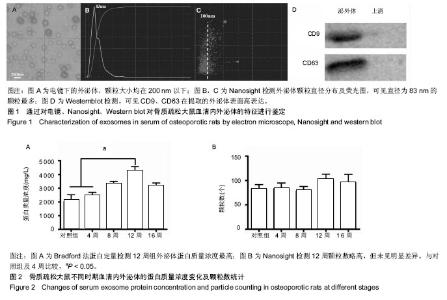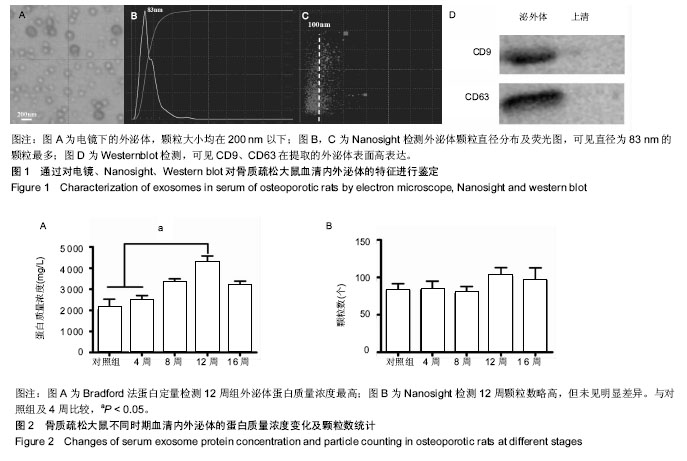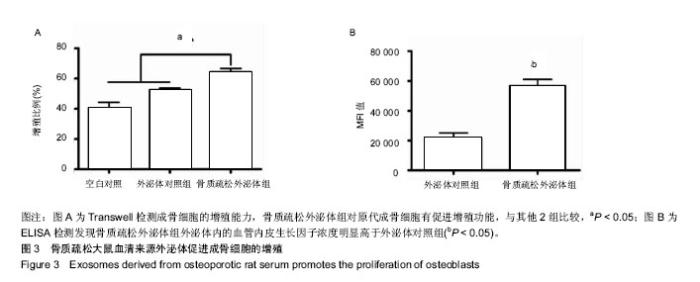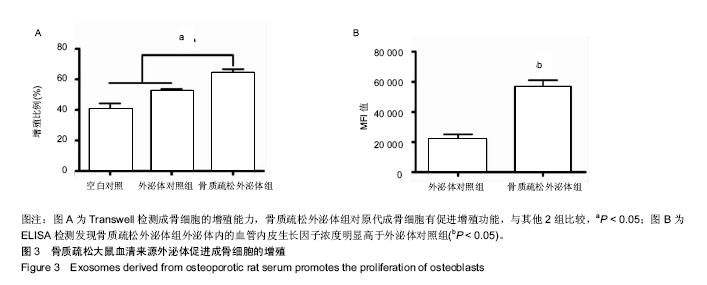| [1] Capulli M, Paone R, Rucci N. Osteoblast and osteocyte: games without frontiers. Arch BiochemBiophys. 2014[2] Kolhe R, Hunter M, Liu S, et al. Gender-specific differential expression of exosomalmiRNA in synovial fluid of patients with osteoarthritis. Sci Rep. 2017;7(1):2029. [3] Xie Y, Gao Y, Zhang L, et al. Involvement of serum-derived exosomes of elderly patients with bone loss in failure of bone remodeling via alteration of exosomal bone-related proteins. Aging Cell. 2018;17(3):e12758. [4] Li D, Liu J, Guo B, et al. Osteoclast-derived exosomal miR-214-3p inhibits osteoblastic bone formation. Nat Commun. 2016;7:10872. [5] György B, Pálóczi K, Kovács A, et al. Improved circulating microparticle analysis in acid-citrate dextrose (ACD) anticoagulant tube. Thromb Res. 2014;133(2):285-292.[6] Rager TM, Olson JK, Zhou Y, et al. Exosomes secreted from bone marrow-derived mesenchymal stem cells protect the intestines from experimental necrotizing enterocolitis. J Pediatr Surg. 2016;51(6):942-947. [7] Van der Meel R, Krawczyk-Durka M, van Solinge WW, et al. Toward routine detection of extracellular vesicles in clinical samples. Int J Lab Hematol. 2014;36(3):244-253. [8] Deng L, Wang Y, Peng Y, et al. Osteoblast-derived microvesicles: a novel mechanism for communication between osteoblasts and osteoclasts. Bone. 2015;79:37-42. [9] Weilner S, Keider V, Winter M, et al. Vesicular Galectin-3 levels decrease with donor age and contribute to the reduced osteo-inductive potential of human plasma derived extracellular vesicles. Aging (Albany NY). 2016;8(1):16-33[10] Cui Y, Luan J, Li H, et al. Exosomes derived from mineralizing osteoblasts promote ST2 cell osteogenic differentiation by alteration of microRNA expression. FEBS Lett. 2016;590(1): 185-192. [11] Ge M, Wu Y, Ke R, et al. Value of osteoblast derived exosomes in bone diseases. J Craniofac Surg. 2017;28(4): 866-870. [12] Peth? A, Chen Y, George A.Exosomes in Extracellular Matrix Bone Biology. CurrOsteoporos Rep.2018;16(1):58-64. [13] Weilner S, Keider V, Winter M, et al. Vesicular Galectin-3 levels decrease with donor age and contribute to the reduced osteo-inductive potential of human plasma derived extracellular vesicles. Aging (Albany NY).2016;8(1):16-33[14] Birmingham E, Niebur GL, McHugh PE, et al. Osteogenic differentiation of mesenchymal stem cells is regulated by osteocyte and osteoblast cells in a simplified bone niche. Eur Cell Mater. 2012;23:13-27. [15] Deng L, Wang Y, Peng Y, et al. Osteoblast-derived microvesicles: a novel mechanism for communication between osteoblasts and osteoclasts. Bone.2015;79:37-42. [16] Herrera MB, Fonsato V, Gatti S, et al. Human liver stem cell-derived microvesicles accelerate hepatic regeneration in hepatec-tomized rats. J Cell Mol Med. 2010;14(6b): 1605-1618. [17] Lai RC, Arslan F, Lee MM et al. Exosome secreted by MSC reduces myocardial ischemia/reperfusion injury. Stem Cell Res (Amst) 2010;4:214-222. [18] Nakamura Y, Miyaki S, Ishitobi H et al. Mesenchymal- stem-cell-derived exosomes accelerate skeletal muscle regeneration. FEBSLett 2015;589:1257-1265. [19] Maes C, Coenegrachts L, Stockmans I, et al. Placental growth factor mediates mesenchymal cell development, cartilage turnover, and bone remodeling during fracture repair. J Clin Invest. 2006;116:1230-1242. |



